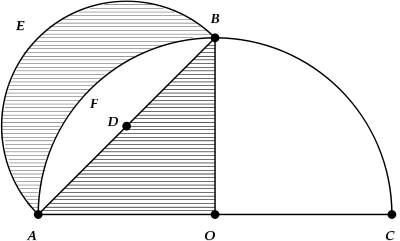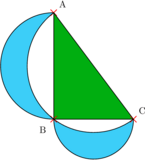Lune of Hippocrates

In geometry, the lune of Hippocrates, named after Hippocrates of Chios, is a lune bounded by arcs of two circles, the smaller of which has as its diameter a chord spanning a right angle on the larger circle. Equivalently, it is a non-convex plane region bounded by one 180-degree circular arc and one 90-degree circular arc. It is the first curved figure to have its exact area calculated mathematically.[1]
History
Hippocrates wanted to solve the classic problem of squaring the circle, i.e. constructing a square by means of straightedge and compass, having the same area as a given circle.[2][3] He proved that the lune bounded by the arcs labeled E and F in the figure has the same area as triangle ABO. This afforded some hope of solving the circle-squaring problem, since the lune is bounded only by arcs of circles. Heath concludes that, in proving his result, Hippocrates was also the first to prove that the area of a disk is proportional to the square of its diameter.[2]
Hippocrates' book on geometry in which this result appears, Elements, has been lost, but may have formed the model for Euclid's Elements.[3] Hippocrates' proof was preserved through the History of Geometry compiled by Eudemus of Rhodes, which has also not survived, but which was excerpted by Simplicius of Cilicia in his commentary on Aristotle's Physics.[2][4]
Not until 1882, with Ferdinand von Lindemann's proof of the transcendence of π, was squaring the circle proved to be impossible.[5]
Proof
Hippocrates' result can be proved as follows: The center of the circle on which the arc AEB lies is the point D, which is the midpoint of the hypotenuse of the isosceles right triangle ABO. Therefore the diameter AC of the larger circle ABC is √2 times the diameter of the smaller circle on which the arc AEB lies. Consequently the smaller circle has half the area of the larger circle, and therefore the quarter circle AFBOA is equal in area to the semicircle AEBDA. Subtracting the crescent-shaped area AFBDA from the quarter circle gives triangle ABO and subtracting the same crescent from the semicircle gives the lune. Since the triangle and lune are both formed by subtracting equal areas from equal area, they are themselves equal in area.[2][6]
Generalizations

As Alhazen showed using a similar proof to the one above, if two lunes are formed on the two sides of a right triangle, whose outer boundaries are semicircles and whose inner boundaries are formed by the circumcircle of the triangle, then the areas of these two lunes add to the area of the triangle. The quadrature of the lune of Hippocrates is the special case of this result for an isosceles right triangle.[7] The lunes formed in this way from a right triangle are known as the lunes of Alhazen, named after the 10th and 11th century Arabic and Persian mathematician Alhazen.[8][9]
In the mid-20th century two Russian mathematicians, Nikolai Chebotaryov and his student Anatoly Dorodnov, completely classified the lunes that are constructible by compass and straightedge and that have equal area to a given square. All such lunes can be specified by the two angles formed by the inner and outer arcs on their respective circles; in this notation, for instance, the lune of Hippocrates would have the inner and outer angles (90°,180°). Hippocrates found two other squarable concave lunes, with angles approximately (107.2°,160.9°) and (68.5°,205.6°). Two more squarable concave lunes, with angles approximately (46.9°,234.4°) and (100.8°,168.0°) were found in 1766 by Martin Johan Wallenius and again in 1840 by Thomas Clausen. As Chebotaryov and Dorodnov showed, these five pairs of angles give the only constructible squarable lunes; in particular, there are no constructible squarable convex lunes.[1][9]
References
- ↑ 1.0 1.1 Postnikov, M. M. (2000), "The problem of squarable lunes", American Mathematical Monthly 107 (7): 645–651, JSTOR 2589121. Translated from Postnikov's 1963 Russian book on Galois theory.
- ↑ 2.0 2.1 2.2 2.3 Heath, Thomas L. (2003), A Manual of Greek Mathematics, Courier Dover Publications, pp. 121–132, ISBN 0-486-43231-9.
- ↑ 3.0 3.1 "Hippocrates of Chios", Encyclopædia Britannica, 2012, retrieved 2012-01-12.
- ↑ O'Connor, John J.; Robertson, Edmund F., "Hippocrates of Chios", MacTutor History of Mathematics archive, University of St Andrews.
- ↑ Jacobs, Konrad (1992), "2.1 Squaring the Circle", Invitation to Mathematics, Princeton University Press, pp. 11–13, ISBN 978-0-691-02528-5.
- ↑ Bunt, Lucas Nicolaas Hendrik; Jones, Phillip S.; Bedient, Jack D. (1988), "4-2 Hippocrates of Chios and the quadrature of lunes", The Historical Roots of Elementary Mathematics, Courier Dover Publications, pp. 90–91, ISBN 0-486-25563-8.
- ↑ Anglin, W. S. (1994), "Hippocrates and the Lunes", Mathematics, a Concise History and Philosophy, Springer, pp. 51–53, ISBN 0-387-94280-7.
- ↑ Hippocrates' Squaring of the Lune at cut-the-knot, accessed 2012-01-12.
- ↑ 9.0 9.1 Alsina, Claudi; Nelsen, Roger B. (2010), "9.1 Squarable lunes", Charming Proofs: A Journey into Elegant Mathematics, Dolciani mathematical expositions 42, Mathematical Association of America, pp. 137–144, ISBN 978-0-88385-348-1.